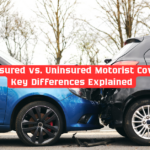Uninsured motorist coverage (UM coverage) is a crucial aspect of auto insurance that protects drivers against financial losses caused by accidents involving uninsured or underinsured motorists. Despite legal requirements in many states for drivers to carry liability insurance, a significant number of drivers remain uninsured. UM coverage ensures that you are not left financially vulnerable in such situations, providing critical support when you need it most.
This guide will explore what uninsured motorist coverage is, how it works, and why it’s an essential part of any auto insurance policy.
What Is Uninsured Motorist Coverage?
Uninsured motorist coverage is a type of auto insurance that covers your expenses if you are involved in an accident caused by a driver who does not have liability insurance. It also applies in hit-and-run accidents where the at-fault driver cannot be identified. UM coverage typically includes:
- Bodily Injury Coverage (UMBI): Pays for medical expenses, lost wages, and other costs related to injuries you or your passengers sustain in an accident caused by an uninsured driver.
- Property Damage Coverage (UMPD): Covers repairs or replacement of your vehicle and other property damaged in the accident.
In many states, UM coverage is required or strongly recommended as part of an auto insurance policy. For more on legal insurance requirements, see What Are the Legal Requirements for Temporary Car Insurance?.
How Does Uninsured Motorist Coverage Work?
UM coverage activates when you are in an accident caused by a driver without adequate insurance. Here’s how it typically works:
- Accident Occurs: You are involved in an accident where the other driver is at fault and does not have liability insurance or cannot be identified (as in a hit-and-run).
- Claim Filing: You file a claim with your own insurance company under your UM coverage.
- Coverage Application: Your insurance company assesses the damages and compensates you for covered expenses, up to the limits of your policy.
UM coverage acts as a safety net, ensuring you are not left bearing the financial burden of someone else’s negligence.
Why Is Uninsured Motorist Coverage Essential?
Financial Protection
Being involved in an accident with an uninsured driver can result in significant out-of-pocket expenses. Medical bills, vehicle repairs, and lost income can quickly add up, leaving you in a difficult financial position. UM coverage eliminates this risk by providing the necessary funds to cover these costs.
Protection in Hit-and-Run Accidents
Hit-and-run accidents can be particularly stressful, as the at-fault driver is often untraceable. UM coverage ensures you are still compensated for damages and injuries, offering peace of mind in these unpredictable situations.
Legal Requirements and Recommendations
While not mandatory in every state, uninsured motorist coverage is often required or strongly encouraged. Even in states where it’s optional, insurance experts recommend including it in your policy due to the high number of uninsured drivers on the road.
Covers Gaps in the Other Driver’s Insurance
In some cases, the at-fault driver may have insurance but not enough to cover all your expenses. This is where underinsured motorist coverage (UIM) comes into play, which is often bundled with UM coverage to protect you against drivers with insufficient coverage.
For insights on situations where temporary insurance is beneficial, refer to What Are the Best Situations to Use Temporary Car Insurance?.
Common Misconceptions About Uninsured Motorist Coverage
- “I Don’t Need It Because I Have Health Insurance”: While health insurance covers medical expenses, it does not address property damage, lost wages, or pain and suffering, which UM coverage can.
- “It’s Expensive”: UM coverage is typically affordable and adds minimal cost to your overall policy compared to the financial protection it provides.
- “All States Require Liability Insurance, So I’m Safe”: Many drivers either fail to purchase insurance or let their policies lapse, making UM coverage essential.
Real-Life Example of UM Coverage in Action
Imagine a scenario where Rachel is driving home and is hit by another driver who runs a red light. The other driver flees the scene, leaving Rachel with a damaged car and minor injuries. Since the at-fault driver cannot be identified, Rachel files a claim under her uninsured motorist coverage. Her policy covers the medical bills and repairs, sparing her from significant financial stress.
How to Choose the Right UM Coverage Limits
When selecting uninsured motorist coverage, consider the following factors:
- State Requirements: Check your state’s minimum coverage requirements for UM insurance.
- Your Financial Situation: Higher coverage limits offer better protection but may increase premiums. Choose limits that align with your financial needs and ability to pay out-of-pocket expenses.
- Vehicle Value: For property damage, ensure your UM coverage limit matches or exceeds the value of your vehicle.
Tips for Maximizing UM Coverage Benefits
- Review Policy Details: Understand the coverage limits, exclusions, and conditions of your policy.
- Bundle with UIM Coverage: Adding underinsured motorist coverage provides additional protection against drivers with insufficient insurance.
- Ask About Add-Ons: Some insurers offer enhancements to UM coverage, such as coverage for pain and suffering or extended property damage protection.
Uninsured motorist coverage is an essential component of any auto insurance policy, offering critical protection in scenarios involving uninsured or hit-and-run drivers. By understanding its benefits and customizing your coverage, you can ensure peace of mind on the road.



